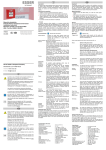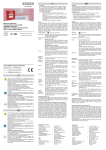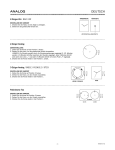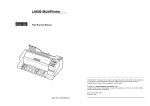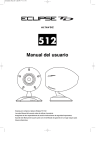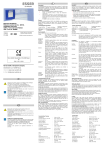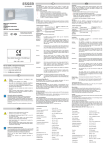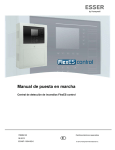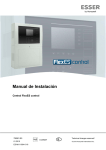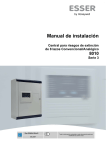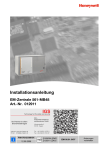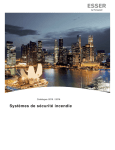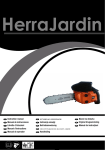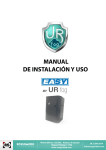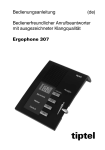Download Manual de Instalación IQ8MCP IP66 Installation Instruction
Transcript
GB Important! These instructions must be studied carefully before commissioning the device. Any damage caused by failure to observe the installation instructions voids the warranty. Furthermore, no liability can be accepted for any consequential damage arising from such failure. Información de seguridad NUNCA conecte el pulsador directamente a 220VAC e instale el pulsador solo dentro el rango de temperatura especificado. Solo técnicos cualificados que estén familiarizados con los riesgos específicos y las normativas correspondientes deben llevar a cabo las operaciones de reparación y mantenimiento del Pulsador. El pulsador no debe ser alterado ni modificado. Safety information NEVER connect the MCP directly to a 230 V AC rated voltage and only operate in the specified ambient temperature range. Only qualified technicians who are fully familiar with all the associated hazards and the applicable legislation and regulations may perform maintenance and repair work on the call point. The call point may not be changed or modified in any way. General El pulsador IQ8 MCP con carcasa roja identificado con un símbolo de una “casa ardiendo” se usa para activación manual de sistemas de alarma u otros sistemas en espacios secos no sujetos a riesgos de explosión. Manual de Instalación IQ8MCP IP66 Installation Instruction IQ8MCP IP66 (Ref. / Part No. 804961) Cambios técnicos reservados! Technical changes reserved! 798937.10 02.2014 / AD Importante! Estas instrucciones deben ser tenidas en cuenta cuidadosamente antes de proceder a la puesta en marcha del equipo. Se declina toda responsabilidad sobre daños derivados y garantía por no seguir estas instrucciones de instalación. GB © 2014 Honeywell International Inc. Funccionamiento Presione el cristal hacia adentro hasta que aparezca la Activar Alarma: lengüeta amarilla (G) en la zona superior de la ventana y el LED Rojo (F) parpadee (Fig. 5). Levante la tapa de llave (A) para insertar la llave Rearme: Fig. 1). Pulsador con lámina de Cristal Abra la caja y retire el cristal. Gire la llave (C) en sentido horario hasta el tope derecho (L) (Fig. 6). Abra la cubierta y reemplace el cristal, gire la llave en sentido contrahorario hasta el tope izquierdo (M) para subir la lámina (Fig. 7). Prueba: Apertura: Símbolo: Cierre: Novar GmbH a Honeywell Company Dieselstraße 2, D-41469 Neuss Internet: www.esser-systems.com E-Mail: info@esser-systems.com § Cuando se usa un Pulsador IQ8 como pulsador de Alarma, se debe usar una carcasa roja con una etiqueta de identificación con el símbolo correcto como es mostrado en Fig. 3 y 4. Cuando se usan diferentes carcasas o diferentes símbolos, el equipo está clasificado como equipo de activación y no como Pulsador de Alarma Observe la secuencia correcta en el cableado de lazo analógico! Terminales 1-4 ULIN (Entrada) ULOUT (Salida). Use cable de comunicaciones claramente identificado I-Y (St) Y n x 2 x 0.8 mm o cable para alarma de incendio! La conexión de la malla del cable debe realizarse al Terminal de tierra para evitar interferencias. Use prensaestopas para cableado para evitar el acceso de humedad. Se debe tener en cuenta durante el mantenimiento o labores de reparación la activación de sistemas de aviso como por ejemplo activación al centro de alarmas. Información adicional y actualizada Las especificaciones se refieren a la fecha de creación del documento y pueden ser modificadas o variadas sobre la normativa aplicada o la información facilitada. Para obtener la información actualizada para mantenimiento o configuración, contacte con su proveedor para que se la facilite o en www.esser-systems.com Revise los manuales del sistema de detección de incendios, para asegurar la compatibilidad con los requerimientos locales. esserbus® and essernet® son marcas registradas Siguiendo normas de instalación de VdS no es posible configurar Pulsadores y Detectores en la misma zona de Detección (máx. 10 MCP por zona de detector. Pulsador con lámina rearmable de plástico Gire la llave (C) en sentido horario hasta el tope derecho (L) (Fig. 6). Coloque la lámina (K) correctamente y gire la llave en sentido contrahorario hasta el tope izquierdo (M) para subir la lámina (Fig. 7). Gire la llave (C) en sentido horario hasta el tope derecho (L) hasta que la lámina caiga y se indique la activación (F/G) (Fig. 4). Para rearmar el equipo gire la llave en sentido contrahorario hasta el tope izquierdo (L), para subir la lámina. Inserte la llave por sus dos patillas en los orificios inferiores de la cubierta (abajo). Presione hacia arriba para liberar la tapa (Fig. 3). Tire desde abajo hacia fuera hasta retirar la tapa. Con la carcasa abierta, quite la lámina transparente de plástico (D/E) presionando hacia afuera, coloque el pictograma adecuado en el frontal, coloque de nuevo la lámina transparente sobre el nuevo pictograma y presione hasta su posición (Fig. 4). Gire la llave en sentido contrahorario hasta su tope izquierdo M (Fig. 7). Coloque la lengüeta superior de la cubierta sobre las ranuras del módulo del pulsador y presione hasta encajar la cubierta en su posición. Trasera del cristal o etiqueta: Para indicar equipo fuera de servicio (J). Lámina de plástico Gire la llave en sentido horario hasta el tope derecho L (Fig. 6). Inserte la lámina o cristal en su posición (H/K) en o cristal: el hueco frontal deslice la lámina hacia arriba girando la llave en sentido contrahorario hasta el tope M (Fig. 7). Kit de protección: La cubierta (N) se inserta en los orificios laterales (O) de la carcasa y puede precintarse (B) (Fig. 2/9). Instalación Para garantizar la portección IP, realice las conexiones de cableado desde la parte inferior cuando sea posible. Corte o taladre solo los orificios necesarios 1-5 por las marcas de la carcasa. En caso nesesario realice taladros M20 y use prensa estopas adecuados (long. min. 15 mm, revise la Fig. 8). Pase el cableado por los prensaestopas y apriete fuertemente para que no penetre la humedad. Para el montaje se precisa llave hexagonal (e.g Torx T10). Fije la caja de forma segura sobre un apared lisa, con los tornillos suministrados y tacos de fijación (S6). Apriete el Pulsador sobre la caja con los tornillos suministrados y juntas para garantizar el grado de protección IP (Fig. 8 / 9). No dañe las juntas de montaje ni la caja. Cableado El pulsador puede conectarse al lazo esserbus® / esserbus®-PLus de una central de detección de incendios. Los pulsadores deben configurarse en sus propias zonas. Retire las protecciones del cable solo en el interior del equipo. Para conectar use los terminales 1-4. Estos terminales son extraíbles para mayor facilidad de instalación. La pantralla del cableado debe interconectarse de forma independiente en un solo conector. La caja dispone de terminal para pantalla (Fig. 2). Aislador de Zona y Zona de detección Los aisladores de zona aseguran el funcionamiento en caso de fallo por cortocircuito. Cuando el cortocircuito ocurre, los aisladores de antes y después del cortocircuito abren y desconectan la sección del lazo. Un solo corte no afecta al funcionamiento del lazo. Puede conectar a este pulsador una zona externa con hasta 10 pulsadores convencionales (Resistencia de alarma de cada pulsador de 1 KOhm). Cuando se produzca la alarma, el panel de detección indicará la dirección y el texto adicional configurado en el equipo al que se conectan. La máxima long. del cable de zona es de 500 metros. Cierre la línea en el último equipo de la zona externa con 10 KOhm. Si no se usa la entrada de zona externa, debe instalarse la resistencia de 10 KOhm entre los terminales 7/8 (Fig. 10). Especificaciones GB When the MCP is used as a manual call point it must be installed in a red housing with an identification label showing the standardize-conformal symbol as shown in Fig. 3/4. When housings with different colours and identification labels are used the unit is classed as a manual activation device and not as a manual call point. Observe the correct wiring sequence for the loop! Terminals 1-4 IN (Input) OUT (Output). Use designated communication cable I-Y (St) Y n x 2 x 0.8 mm or fire alarm cable! Connection of the cable shield to the ground terminal protects the signal cables against interference. Install inlaying cable with a dripping bend to protect the device from dampness. The alarm activation and triggering of notifying systems e.g. manned centre link (Master box) must be observed during any Service of the MCP. Additional and updated Informations The product specification relate to the date of issue and may differ due to modifications and/or amended Standards and Regulations from the given informations. For updated informations to commissioning and maintenance of Fire alarm detectors refer to www.esser-systems.com Observe technical manuals of the FACP to ensure compliance to standards and local requirements of Systems features! esserbus® and essernet® are registered trademarks in Germany. § Pursuant to the VdS guidelines MCPs and automatic fire detectors must not be operated in a common detector zone (máx. 10 MCP per detector zone). General / Application The IQ8MCP in the red housing identified with a “burning house” symbol is designated for use as a call point for manually triggering fire alarms or other hazard alarms in dry workplaces not subject to explosion hazards. Operation Trigger alarm: Press screen centre inwards until the yellow tab indicator (G) is visible in the upper area and the red LED (F) lits (Fig. 5). Reset: Push up the keyhole cover (A) to insert the key (Fig. 1). Detector with glass screen Open MCP and remove the broken glass. Turn key (C) clockwise until the right (L) stop position (Fig. 6). Replace glass screen, close MCP and turn key anti-clockwise until the left (M) stop position to lift screen upwards (Fig. 7). Detector with plastic operating panel Turn key (C) clockwise until the right (L) stop position (Fig. 6). Align the plastic operating panel (K) and turn key anti-clockwise until the left (M) stop position to lift screen upwards (Fig. 7). Test mode: Turn key (C) clockwise (L) until the screen moves downwards and the activation (F/G) is indicated (Fig. 4). To reset the detector after a test simply turn key to the left (M) stop position to lift screen upwards. MCP opening: Insert the key with the both tenons in the opening at the bottom of the housing (Fig. 3) to release the cover lock. Lift up the bottom edge of the cover a little to release it and then remove it. MCP Symbolism: With the housing open, remove the transparent plastic cover (D/E) by prising it out. Insert the appropriate identification label from the front. Align the cover and snap it back into place (Fig. 4). Turn key lock anti-clockwise until the left (M) stop position (Fig. 7). Position the upper edge of the cover in the groove at the top of the base and then press the cover down until it locks into position. MCP closing: Glass screen rear side or Paper inlay: Plastic operating panel or glass screen: Protection kit: To indicate that the MCP is Out-of-Order (J). Turn key lock clockwise until the right (L) stop position (Fig. 6). Insert screen (H/K) aligned in the front recess and move screen upwards by turning the key anticlockwise until the left (M) stop position (Fig. 7). The cover (N) is fixed by the sideway dents (O) of the housing and may be plumbed (B) if required (Fig. 3/9). Installation To ensure optimal IP protection, attach cable screw connections to the underside of the mounting box, where possible. Cut or drill all required cable entries 1-5 only at the marked housing tags. If necessary deburr openings and fit suitable cable threads M20 (length min. 15 mm,option, refer to Fig. 8). Run the cable in and tighten the screw connection so that no moisture or the like can enter. A hex head tool (e.g Torx T10) is required for mounting. Attach the mounting box securely to a suitable wall with a smooth surface, with supplied screws and enclosed dowels (S6). Fasten the MCP to the housing with the supplied screws incl. sealing ring to ensure the IP-protection rating (Fig. 8 / 9). Do not damage rubber seals of the MCP and mounting box! Wiring ® ® The MCP can be connected to the esserbus / esserbus -PLus loop of a fire alarm control panel. Manual call points must be configured together in their own detector zones. Only remove insulation from cable sections inside the housing. For wiring use terminals 1-4. These terminals can be removed to simplify the installation. The cable shield of the connection cable must be interconnected by using a single terminal block. The mounting box provides an integrated terminal for the shield connection (Fig. 2). Zone isolator and ext. detector zone The zone isolators ensure that the system continues to function even if a segment circuit fails due to a short circuit. When a short occurs the zone isolators before and after the short open, disconnecting the section of the loop between the isolators. Simple wire breaks do not affect the functionality of the loop circuit. You can connect an external detector zone with up to ten conventional MCP (internal Alarm resistor for each MCP 1 KOhm). When an alarm is triggered the address and the programmed additional text of the MCP to which the ext. detector zone is connected are displayed automatically. Cable length max. 500 metres! Fit the last conventional MCP with a 10 KOhm terminating resistor. If no ext. detector zone is connected the 10 KOhm resistor must be connected directly across terminals 7/8 (Fig. 10). Alimentación : 8 VCC a 42 VCC Consumo Reposo : aprox. 45 μA a 19 VCC Consumo Alarma : aprox. 9 mA a 19 VCC, pulsante Specifications Número de Pulsadores : máx. 127 equipos (por lazo) Power supply : 8 V DC to 42 V DC Quicent current : approx. 45 μA @ 19 V DC Alarm current : approx. 9 mA @ 19 V DC, pulsed MCP number : max. 127 MCP (per loop) Indicación de Alarma : LED rojo y pestaña amarilla Indicación funcionamiento : LED verde Terminales : máx. 1,5 mm² (AWG 30-14) Temperatura de aplicación : -20 °C a +70 °C Alarm indicator : red LED and yellow tab Temperatura almacenamiento : -30 °C a +75 °C Operation indicator : green LED Grado de Protección : IP 66 Connection terminals : max. 1,5 mm² (AWG 30-14) Carcasa : Plástico PC/ASA Application temperature : -20 °C to +70 °C Color : Rojo (similar RAL 3020) Storage temperature : -30 °C to +75 °C Peso : aprox. 255 g Protection rating : IP 66 Dimensionaes (a x h x f) : 88 x 88 x 27 (mm) Housing : PC/ASA plastic Dimensiones con caja : 88 x 88 x 63 (mm) Colour : red (similar RAL 3020) Especificaciones : EN 54-11:2001 / A1:2005, Typ A; EN 54-17:2005 Weight : approx. 255 g Dimensions MCP (w x h x d) : 88 x 88 x 27 (mm) Dimensions incl. mounting box : 88 x 88 x 63 (mm) Specification : EN 54-11:2001 / A1:2005, type A; EN 54-17:2005 VdS approval : G 205132 Declaration of Performance : DoP-20493130701 Certificado VdS : G 205132 Cerificado CPR : DoP-20493130701 GB Opciones Ref. Options Part No. Cristal de repuesto (10 Uds.) 704960 Replacement glass screen (10 pieces) 704960 Etiqueta transparente para impresión de otros iconos (10 Uds.) 704961 Label, transparent with whit printing, differing from standard icons (10 pieces) 704961 Lámina de plástico rearmable (K) (10 Uds.) 704964 Plastic operating panel (K) resettable, white (10 pieces) 704964 Llave de repuesto (10 Uds.) 704964 Replacement key (10 pieces) 704966 Vea el catálogo de producto para más opciones See product group catalogue for additional accessories Montaje / Mounting 27 88 15 88 36 D 79 B 88 79 88 TOP C E A Fig.1: Dimensiones en mm Fig. 1: Dimensions in mm Fig.2: Montaje caja de superficie (Ref. 704990) Fig. 2: Mounting box for surface mounting (Part No. 704990) Glasscheibe Glass screen F Fig. 4: Etiqueta símbolo Fig. 4: Identification label Rückseite Rear side Oben Top G Fig. 3: Apertura de caja. Precinto (B) Fig. 3: Open the housing / seal (B) Out of Order Außer Betrieb oder or H Kunststoffbedienfeld (Option) Plastic operating panel (Option) Oben Top Papiereinleger Paper inlay Out of Order Außer Betrieb oder or M L K J Fig. 5: Indicador mecánico de alarma y LED, lámina de cristal, inserción de pictograma y lámina de plástico Fig. 5: Mechanical alarm indicator and LED, Glass screen, paper inlay and plastic operating panel Fig. 6: Posición de la llave para prueba y retirar la lámina Fig. 6: Key lock position for test mode and removing screen Fig. 7: Cambiar la lámina y posición de llave para cierre y rearme Fig. 7: Replace screen / Key lock position for Reset 1 3 4 1 N 1 5 2 1 2 1 O 2 Fig. 8: Ejemplo de instalación para entradas de cable 1-5 Fig. 8: Installation example for cable entries 1-5 Máx. 4 tornillos para montaje en superficie / max. 4 screws for wall mounting 2 tornillos para fijación en la caja / 2 screws to fix MCP onto mounting box Fig. 9: Instalación en superficie Fig. 9: MCP wall installation A+ A- B+ B- Revise el torque máximo de los terminales (máx. 0,4 Nm). Observe permitted torque (máx. 0.4 Nm) of the terminals! Fig. 10: Cableado de lazo Fig. 10: Wiring loop 804961 8 7 6 5 C4 C3 OUT 2 IN 1 10K 8 7 6 5 C4 C3 OUT 2 IN 1 Ringmodul Loop Module 10K 804961 10K 804961 8 7 6 5 C4 C3 OUT 2 IN 1 Conexionado / Wiring


